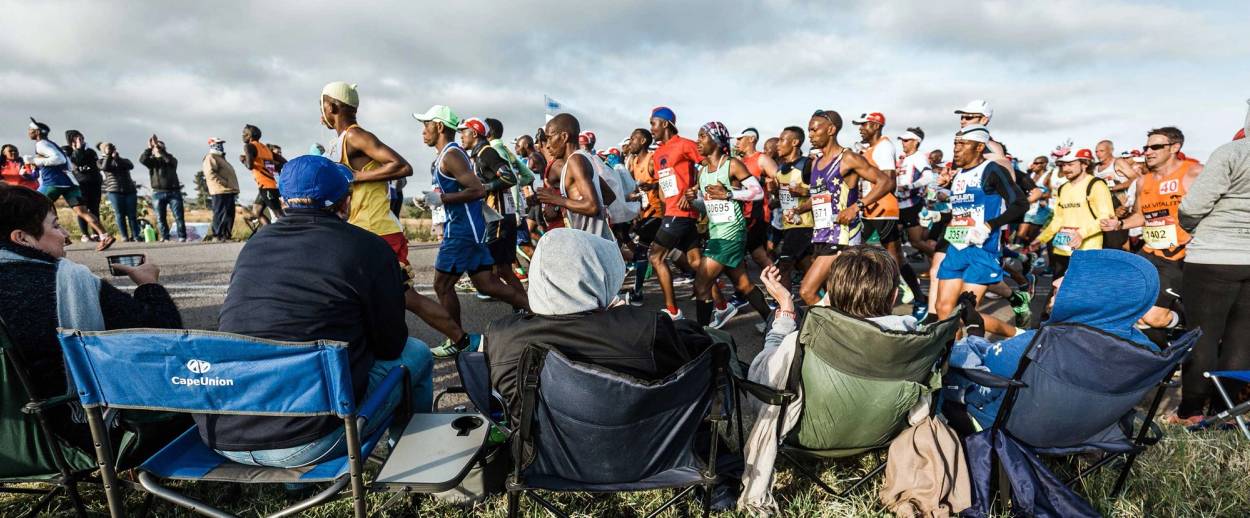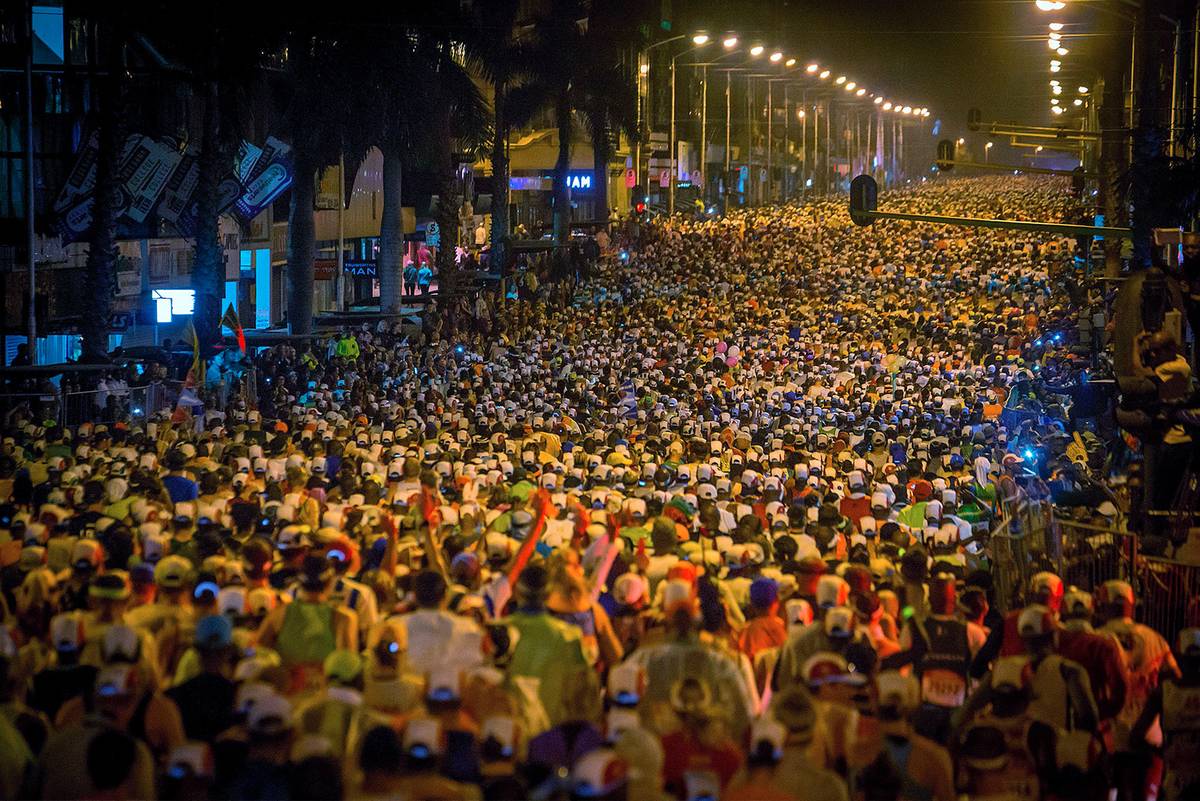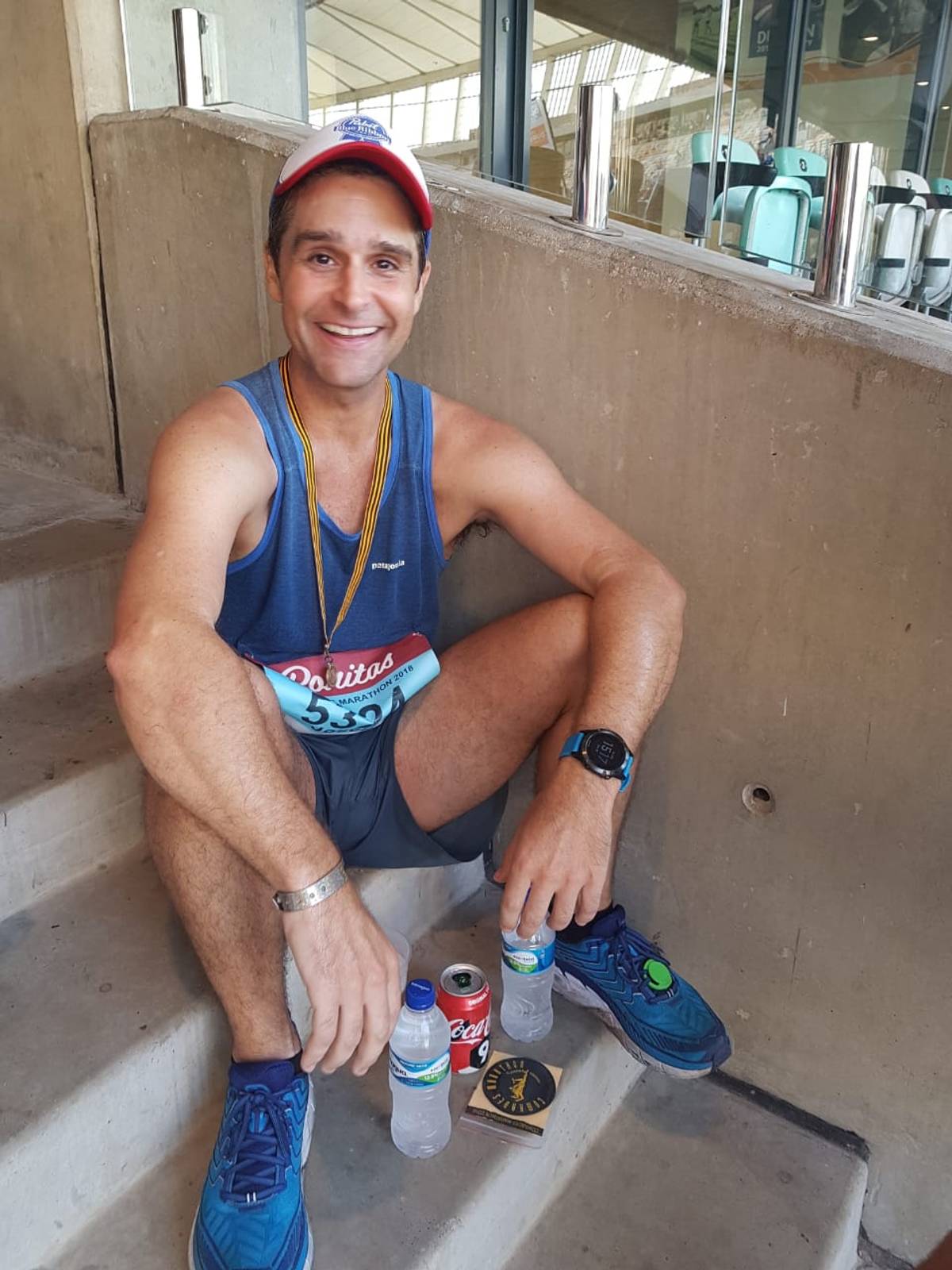Comrades, Run!
How a grueling 56-mile ultramarathon in South Africa became a stage for racial reconciliation—and national belonging for immigrant Jews




At the end of a Shabbat dinner with family and friends in May, I found myself on the phone with one of the greatest South African runners of all time. The voice on the other end of the phone was Bruce Fordyce. While he might not be known outside of the country, Fordyce is the Michael Jordan of South African running. “Joseph,” he said over the phone, “you’ve made the worst decision of your life but you’re going to love every minute of it.”
He was referring to my decision to run the Comrades Marathon—a grueling 56-mile ultramarathon near Durban that is one of South Africa’s most beloved, admired, and watched sporting events in an already sport-obsessed country. Running the Comrades is a feat that creates immediate respect among peers and family in South Africa. Many finishers even include it on their resume.

The Comrades was a continuous topic of conversation during that Shabbat in May. Five of the men present, all over the age of 60, had run the Comrades—most more than once. Their eyes lit up when I announced I was running this year, and stories about the race flowed freely. They told me about training in the late 1970s and how sometimes they had to skip races because they fell on the first night of Passover. Back then, most of their friends and peers ran ultramarathons like the Comrades. Today, their children are into CrossFit and Pilates.
One guest told me how he sat down one year about five miles from the Comrades finish line, convinced he couldn’t take another step. A random runner stopped to check on him and after a brief chat they discovered they were both Jewish. The stranger helped him across the finish line. Years later, they bumped into each other in a Cape Town restaurant. “You might not remember me, but we finished the Comrades together in 1985,” the random runner said.
As an outsider who has made South Africa my adopted home, I approached the Comrades not only as a personal physical test of my running ability and fitness but also as a way to learn about South African society from the inside. The Comrades’ spirit, which runners say captures the unusual appeal of the event, is both uniquely South African and universal. During the apartheid era, the Comrades played an important role in society as both a national event for the regime and a space for political dissent and eventually reconciliation.
For the Jewish community, as I discovered in the course of training, the Comrades was part of a muscular form of Judaism that emerged in South Africa in the late 1970s and early 1980s. “The Comrades Marathon is a continuation of the integration of minority groups in South Africa,” Milton Shain, professor emeritus of history at the University of Cape Town and the author of many books about South African Jewry, told me. Indeed, in post-apartheid South Africa sport has been used to bring South Africans together, and the Comrades occupies a special place in the country’s cultural mosaic.
***
The Comrades Marathon began in 1921 as a tribute to fallen soldiers who lost their lives in World War I. Vic Clapham, a war veteran and the organizer of the race, felt it was a fitting tribute to the camaraderie those soldiers displayed on the battlefield. On a cold winter morning in May of that year, 34 runners gathered in Pietermaritzburg, a hamlet roughly 50 miles outside South Africa’s third-largest city, Durban. Sixteen people finished the 56-mile run that day, and the Comrades was born. Other than a break during World War II, the Comrades has been run every year since.
Twice the distance of a standard marathon, the Comrades is the world’s oldest and largest ultramarathon. The run alternates directions every year, starting in Durban and finishing in Pietermaritzburg or vice versa. The direction counts for a lot, as Durban is on the sea and Pietermaritzburg is tucked away in the mountains. On the years when the race starts in Durban (known as an “up run”), runners face grueling climbs for the first 26 miles of the race; every other year, when the race starts in Pietermaritzburg, runners face punishing descents in the second half of the race, which counterintuitively is much harder because of the pounding the quads take in downhill running. With barely a single continuous mile of flat road, the Comrades can best be described as mountainous instead of hilly.
Traditions play an outsize role in the Comrades experience. For one, the race is run “gun to gun.” Unlike major marathons, where a runner’s time begins when they cross the start line, the race time in the Comrades starts as soon as the starting gun is fired. With more than 20,000 people starting the race this year, some people in the back of the starting area lost eight minutes before they even crossed the start line.
The best strategy for finishing Comrades is to never stop moving forward
This might not sound like much but the Comrades has a strict 12-hour cutoff time and the large majority of runners finish in the final 30 minutes of the race. As such, one runner is invariably left standing before the finish line having missed the cutoff by a handful of seconds despite running the entire 56-mile course. The stranded runner becomes something of a momentary legend in South Africa as the media rushes in for interviews. Such is the grit and brutality of the Comrades. Until the mid-1970s, only white men were allowed to run but there had been several unofficial black and female runners before that time.
It wasn’t until the early 1980s that the Comrades became a space of open political dissent as well as inclusive running. In 1981, a group of white students led protests against the Comrades being held on Republic Day (the apartheid regime’s independence day) and called for a boycott of the race. Running legend Bruce Fordyce, who went on to win the Comrades nine times (eight of those wins were consecutive in the 1980s), ran that year wearing a black armband in protest of apartheid. Images of Fordyce winning the race with the black armband were carried live on South African national television.
At that time, South Africa was banned from international sporting events such as the Olympics and the soccer World Cup as a result of a sweeping sports boycott. The national rugby and cricket teams were met with protests everywhere they traveled, and South African sport, like the rest of society, was segregated. For a country obsessed with sport, the isolation resulted in local sports taking on a national dimension and the Comrades was at the forefront of this trend. As the apartheid regime slowly lost control of the country and the edifice of segregation began to crumble in the late 1980s, the Comrades became a race in which black and white athletes lined up together for a challenging ultramarathon in the rolling hills of KwaZulu-Natal.
***
My late father-in-law had run the Two Oceans marathon twice in the early 1980s. Many of his friends had run the Comrades. As I got more into running, it struck me that South Africa had an unusually high concentration of Jewish ultramarathon runners. Was this just a coincidence or did sport, and running in particular, play a role in the integration of the Jewish community into South African society?
Numbering 60,000, the South African Jewish community is not large. The majority trace their origins to greater Lithuania. My wife’s grandmother was born in Lithuania and escaped the growing violence and anti-Semitism for South Africa in the 1930s. Having fled Europe, the Jews had an undying sense of unease in South Africa, where they were tolerated, but anti-Semitism was rife. With the rise of the National Party (NP) and creation of apartheid laws, the Jews were classified as white by the regime, and granted full privileges in society. But the sense of unease never dissipated.

“Jews were pretty fearful in 1948 when apartheid came into being for two major reasons,” Shain told me on a rainy day in Cape Town. “One, the national party that came to power had been if not pro-Nazi, anti-war. They had harbored many anti-Semites and shown some sympathy for the radical fascist right. The second reason is that the community was largely from Lithuania and they had seen their co-religionists murdered. It was very real for them.”
Despite the fear, the Jewish community as a whole did little to publicly challenge the status quo during apartheid. While the white anti-apartheid left was disproportionately Jewish, activists such as Denis Goldberg and Lazar Sidelsky often found themselves at odds with mainstream Jewish institutions. “The community had a moral issue with apartheid insofar as the racist laws were clearly against any Jewish teachings or values,” Shain noted. “But this is not to say that Jews had not generally imbibed the normative values of a white settler society where they enjoyed all the privileges and shared some of the racist attitudes which were built into the colonial experience.”
Beginning in the mid-1970s, a form of muscular Jewishness took shape in South Africa. Fears of anti-Semitism persisted but by that time the Jewish community served an important cultural, economic, and even political function in white South African society. Mandatory military conscription of Jewish men continued, but the nature of military service changed. No longer sent to sleepy outposts, Jews found themselves on the frontlines of South Africa’s border conflicts and sent into black areas to suppress protests.
For white English and Afrikaans society, sport was a critical component of colonial masculinity. The Comrades Marathon, given its length and difficulty, played into the masculine sense of grit and strength that flowed through white society. Therefore, it is hardly surprising that Jewish men began running the Comrades and taking part in other sporting pursuits around this time. The community was sending a message that it could be South African and participate in South African things like running the Comrades.
***
Around 30 miles into the Comrades, the race was unfolding beautifully for me. I had emerged from a difficult stretch near a long and sustained hill called Inchanga, which means “the blade of a spear” in Zulu. I was confident I wouldn’t bonk, a term runners use when one’s blood sugar drops and the body slows down, as I had been drinking Coca-Cola and eating boiled potatoes throughout the entire race (an old-school South African form of nutrition for ultramarathons).
The crowds along the entire stretch of road were unlike anything I had experienced. Imagine the crowds of the New York City marathon but for 56 miles. I lost track of how many people yelled out my name when they read it on my race bib. Because I had an international race number, spectators reveled in the opportunity to welcome me to their country. “Thank you for coming to South Africa,” random people screamed. “You can stay as long as you want!”
While official racial segregation has ended, post-apartheid South Africa remains defined by race and class. In Cape Town, for example, wealthy residents live on one side of the city’s iconic Table Mountain while poor residents live in shanty towns on the other side. Some 30 miles separates two completely different worlds.
But during the Comrades, divisions fade. Runners come from every sector of society. There are wealthy Afrikaner running clubs and poor running clubs from black shanty towns. As clichéd as it might sound, it doesn’t matter at all where you are from or how much money you make. Late in the race, you look around at your fellow runners and you know they too are suffering. Pain is the great equalizer. It does more to break down barriers than any effort the government has tried since the fall of apartheid.
There are still a large number of Jews who run the Comrades. In fact, Chabad sets up a station around mile 37 where Jews can lay tefillin or get a kosher snack. They say the best strategy for finishing Comrades is to never stop moving forward, even if that means walking for a bit. I had to laugh as I saw Chabad volunteers running alongside runners putting on phylacteries and reciting prayers.
The role the Comrades once played for Jews as a vehicle for integration into white South African society has passed. However cautious they are about the current political climate in South Africa and the government’s fraught relationship with Israel, the South African-Jewish community is an established part of the society.
This year, the race finished in a soccer stadium that was built for the 2010 soccer World Cup. As I took my first steps on the soft grass of the stadium, a wave of emotion washed over me. Months of training and years of pining for that finish line had finally arrived. Around me, perfect strangers who had run the final portion together embraced, most with tears in their eyes. My race time was nine hours and 40 minutes—safe from the carnage of the final cutoff but no less emotional.
***
Like this article? Sign up for our Daily Digest to get Tablet Magazine’s new content in your inbox each morning.
Joseph Dana is a writer living in Cape Town, South Africa.